AMD Radeon R9 290 4GB Review
Manufacturer: AMDUK price (as reviewed): MSRP £320 (inc VAT)
US price (as reviewed): MSRP $399 (ex Tax)
Thermal and power consumption issues aside, the Hawaii GPU made a great debut in the AMD Radeon R9 290X, with performance that was faster than the GTX 780 (and relatively close to the GTX Titan), yet priced £50 less than it. Naturally, Nvidia had no choice but to slash prices, and indeed it recently dropped the GTX 780 by a whole £100, down to £400, which also conveniently makes room for the imminent GTX 780 Ti. The R9 290X now sits at £430, so the price-performance scale is relatively well balanced again at the high end (excluding Titan). Nvidia also dropped the GTX 770's price to £240, to not only leave an appropriate distance between it and the GTX 780 but also in anticipation of AMD's Radeon R9 290 4GB. This is what we're looking at today, and it is set to enter the UK market at around £320, which is smack bang in the middle of the new pricing for Nvidia's GTX 770 and GTX 780 cards.
If you want the full low down on the Hawaii GPU found in the R9 290, as well as the various new technologies surrounding it, you'd be wise to check out our more in-depth R9 290X review. Both cards use the same 6.2 billion transistor Graphics Core Next GPU produced on a 28nm process node, and while there's a few changes in the specifications, physically the two are identical.
The main change to the underlying hardware is in the Compute Unit count, which has been reduced from 44 to 40. This is a moderate 9 percent decrease, and still leaves the R9 290 with 8 more CUs than the R9 280X, the next card down. Consequently, the texture unit count has fallen from 176 to 160, while stream processors are down from 2,816 to 2,560. It is unclear whether the 40 CUs are divided evenly between the card's Shader Engines (SEs) or whether it's an uneven split or varies from card to card, as AMD declined to clarify the matter when we asked them, stating only that they 'disable the compute units in such a manner to deliver optimal performance'.
| AMD Radeon R9 290X | AMD Radeon R9 290 | AMD Radeon R9 280X | AMD Radeon R9 270X | |
| GPU | ||||
| Codename | Hawaii XT | Hawaii Pro | Tahiti XTL | Curacao XT |
| Core Clock | Up to 1GHz | Up to 947MHz | Up to 1GHz | Up to 1.05GHz |
| Stream Processors | 2,816 | 2,560 | 2,048 | 1,280 |
| Texture Units | 176 | 160 | 128 | 80 |
| Rasterisers | 4 | 4 | 2 | 2 |
| Tesselation Units | 4 | 4 | 2 | 2 |
| ROPs | 64 | 64 | 32 | 32 |
| Transistors | 6.2 billion | 6.2 billion | 4.3 billion | 2.8 billion |
| Die Size | 438mm2 | 438mm2 | 352mm2 | 212mm2 |
| Process Node | 28nm | 28nm | 28nm | 28nm |
| Memory | ||||
| Amount | 4GB GDDR5 | 4GB GDDR5 | 3GB GDDR5 | 2GB or 4GB GDDR5 |
| Frequency | 1.25GHz (5GHz effective) | 1.25GHz (5GHz effective) | 1.5GHz (6GHz effective) | 1.4GHz (5.6GHz effective) |
| Interface | 512-bit | 512-bit | 384-bit | 256-bit |
| Bandwidth | 320GB/sec | 320GB/sec | 288GB/sec | 179.2GB/sec |
| Card Specifications | ||||
| Power Connectors | 1 x 8-pin, 1 x 6-pin | 1 x 8-pin, 1 x 6-pin | 1 x 8-pin, 1 x 6-pin | 2 x 6-pin |
| Stock Card Length | 278mm | 278mm | 275mm | 240mm |
| TDP | ~300W | ~300W | 250W | 180W |
| Typical Street Price | £430 | £320 | £240 | £150 |
Elsewhere, Hawaii remainsin tact and fully accessible to the R9 290. The Shader Engines are fed by eight Asynchronous Compute Engines as well as the graphics command processor, which can all operate simultaneously. As well as the Compute Units, The four SEs also contain one geometry processor and one rasteriser each, as well as four render-back end units of four ROPs a piece, for a total ROP count of 64. The final difference between them is that the R9 290 is clocked at 947MHz, whereas it's the full 1GHz in the R9 290X.
The R9 290 retains the full 512-bit memory interface thanks to its eight 64-bit memory controllers, as well as the same 4GB GDDR5 memory. The memory stays clocked at 5GHz, for a total memory bandwidth of 320GB/sec.
The card also contains the TrueAudio DSP like the R9 290X and R7 260 (its specification is the same regardless of which card it's on). This is AMD's programmable audio pipeline, and you can read about it in greater depth here.
Like the R9 290X, the R9 290 also uses the PCIe lanes for CrossFire, so there's no need for external bridges or their connectors. Naturally, AMD's upcoming API for GCN products, Mantle, is also fully supported.
The dual slot reference R9 290 4GB card is, like the 290X, 278mm long. We again find the red and black plastic shroud atop a copper and aluminium heatsink, with a radial fan that blows air straight through the card and out the rear I/O. The memory chips and power circuitry are actively cooled as well, with a large black metal plate used to absorb their heat and feed the main heatsink.
This is the design we're stuck with until AIBs are able release their custom cooled ones later this year. The lack of heatpipes in the 290X's cooler seemed to contribute to its high running temperature, so it'll be interesting to see how the 290 holds up.
The similarities continue with video outputs, with the same two DVI-D (Dual Link) ports, DisplayPort 1.2 connector and HDMI 1.4b output. The card supports three identical monitors in Eyefinity without the use of DisplayPort, while the DisplayPort connector itself is ready for single stream 4K resolutions at 60Hz. There's also support for the VESA Display ID v1.3 specification and Automatic AMD Eyefinity configuration of tiled displays. All of this is explained in greater detail here if you're interested.
On the actual PCB, the large GPU sits surrounded by the 16 SK Hynix memory chips, all of which are mounted on the front side. AMD has retained the dual BIOS switch from the R9 290X but unlike that card it's not loaded with different BIOS profiles. However, the profiles only changed the R9 290X's maximum fan speed, something that could be achieved more quickly through software anyway, so it's no big loss. The R9 290's maximum fan speed is set by default to 40 percent, the same as the R9 290X's 'Quiet Mode', and we left it at this setting for all stock speed tests.
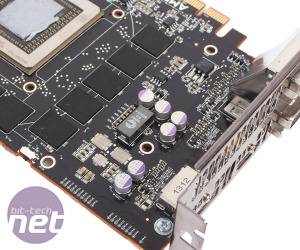
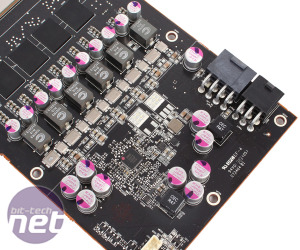
Click to enlarge - The R9 290 has no need for CrossFire connections (left), and the rear of the card houses its SVI2 VR controller
The board also sports two power connectors, a 6-pin and an 8-pin. Power is routed through the SVI2 VR controller, the heart of AMD's new approach to PowerTune, and delivered through a standard 5+1 phase power design. AMD ZeroCore Power is another feature that's carried over too, enabling the card (and any unused card in Crossfire) to shut down when the system is idling.

MSI MPG Velox 100R Chassis Review
October 14 2021 | 15:04


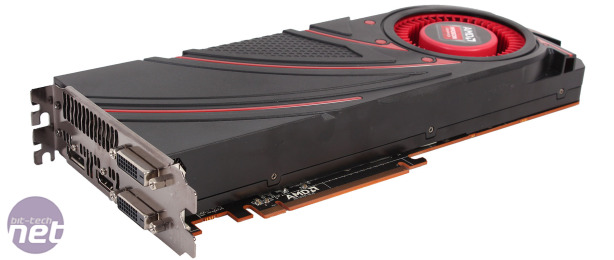
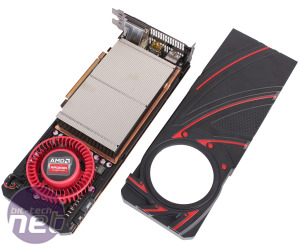
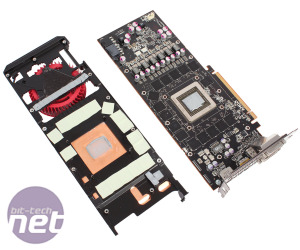
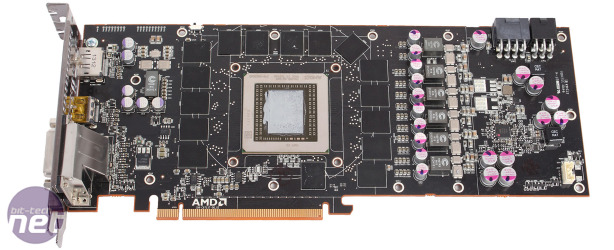







Want to comment? Please log in.